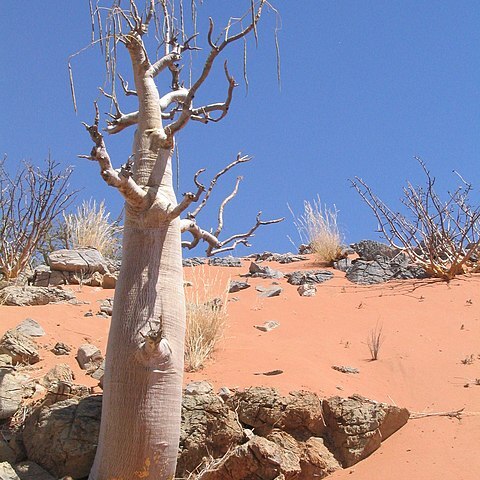Small trees, mostly deciduous, bark gummy, wood soft, roots thickened, pungent; trunk often inflated. Leaves spread, imperfectly 2-4-imparipinnate; tissue with myrosin cells; pinnae opposite, provided with stipitate glands at the base of the petiolules and pinnae. Leaflets small, opposite, entire, all articulated. Stipules represented by blunt knobs. Flowers bisexual, zygomorphic, white (or yellow streaked red), in axillary panicles. Calyx tube short, as a hypanthium; lobes 5 imbricate, spreading or reflexed, separately dropping. Petals 5 free, anterior one largest and erect, others reflexed, posterior smallest. Disk lining the calyx tube, with a short free margin bearing the androecium. Perfect stamens 5 epipetalous; anthers dorsifixed, 1-celled, oblong, when lengthwise opened broader. Staminodes 5, subulate, with or without rudimentary anthers. Ovary superior, shortly stalked, 1-celled with 3 parietal placentas. Style filiform, stigma small. Ovules ∞, in 2 series on each placenta. Capsule linear, beaked, 3-6-angled; valves thick, spongy, on the inside with pitted cavities in 1 row along the median line. Seeds 3-winged (or exalate), body roundish large. Embryo exalbuminous, straight, containing oil.
More
Trees or shrubs, [massive pachycauls, baobab-like with water-storing trunk], slender-trunked. Leaves: stipules with nectaries at growing tip; rachis articulation with stalked glands; [1-pinnate](2-)3-4(-5)-pinnate; leaflet blade membranous [subcoriaceous], [lanceolate, oblanceolate, linear] round or oval, venation sometimes conspicuous abaxially, apex glandular, surfaces [pubescent] puberulent or glabrous. Flowers: parts usually with hairs forming a barrier distal to the nectariferous hypanthium; 1 sporangium initiated in anther ontogeny. Capsules 2-valved, often constricted between seeds. Seeds [1]2-3 cm, winged [not winged], sometimes with spongy seed coat, shed by gravity. x = 11.
Morphological characters and geographical distribution are the same as those for the family.
Description as for family.
Said to be deciduous, but M. oleifera is to my knowledge in Malaysia never wholly so, thriving both under wet and seasonal conditions. As far as is known M. oleifera never runs wild.

